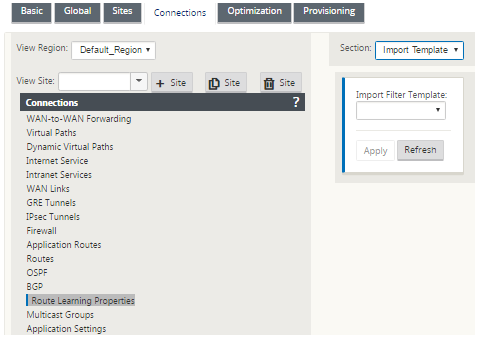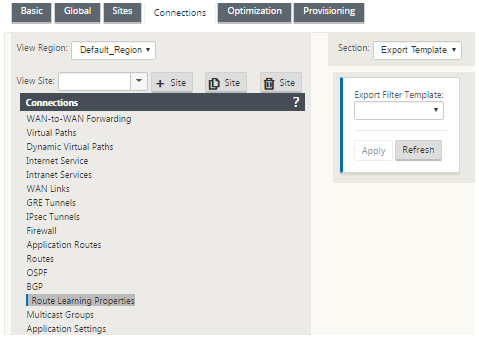-
Configuration guide for Citrix Virtual Apps and Desktops™ workloads
-
Citrix SD-WAN Orchestrator™ on-premises configuration on Citrix SD-WAN appliance
-
-
Route filtering
-
This content has been machine translated dynamically.
Dieser Inhalt ist eine maschinelle Übersetzung, die dynamisch erstellt wurde. (Haftungsausschluss)
Cet article a été traduit automatiquement de manière dynamique. (Clause de non responsabilité)
Este artículo lo ha traducido una máquina de forma dinámica. (Aviso legal)
此内容已经过机器动态翻译。 放弃
このコンテンツは動的に機械翻訳されています。免責事項
이 콘텐츠는 동적으로 기계 번역되었습니다. 책임 부인
Este texto foi traduzido automaticamente. (Aviso legal)
Questo contenuto è stato tradotto dinamicamente con traduzione automatica.(Esclusione di responsabilità))
This article has been machine translated.
Dieser Artikel wurde maschinell übersetzt. (Haftungsausschluss)
Ce article a été traduit automatiquement. (Clause de non responsabilité)
Este artículo ha sido traducido automáticamente. (Aviso legal)
この記事は機械翻訳されています.免責事項
이 기사는 기계 번역되었습니다.책임 부인
Este artigo foi traduzido automaticamente.(Aviso legal)
这篇文章已经过机器翻译.放弃
Questo articolo è stato tradotto automaticamente.(Esclusione di responsabilità))
Translation failed!
Route filtering
For networks with Route Learning enabled, Citrix SD-WAN™ provides more control over which SD-WAN routes are advertised to routing neighbors rather and which routes are received from routing neighbors, rather than advertising and accepting all or no routes.
-
Export Filters are used to include or exclude routes for advertisement using OSPF and BGP protocols based on specific match criteria. Export filter rules are the rules that have to be meet when advertising SD-WAN routes over dynamic routing protocols. All the routes are advertised to peers by default.
-
Import Filters are used to accept or not accept routes which are received using OSPF and BGP neighbors based on specific match criteria. Import filter rules are the rules that have to be meet before importing dynamic routes into the SD-WAN route database. No routes are imported by default.
Route filtering is implemented on LAN routes and Virtual Path routes in an SD-WAN network (Data Center/Branch) and is advertised to a non-SD-WAN network through using BGP and OSPF.
You can configure up to 512 Export Filters and 512 Import Filters. This is the overall limit, not per routing domain limit.
Configure export filters
In the Configuration Editor, navigate to Connections > Regions > Site > OSPF or BGP > Export Filters.

Use the following criteria to construct each Export Filter that you want to create.
| Field Criteria | Description | Value |
|---|---|---|
| Order | The Order in which filters are prioritized. The first filter that a route matches are applied to that route | 100, 200, 300, 400, 500, 600 |
| Network Address | Enter the IP address and subnet mask of configured Network Object that describes the route’s network |
|
| Prefix | To match routes by prefix, choose a match predicate from the menu and enter a Route prefix in the adjacent field |
|
| Citrix SD-WAN Cost | The method (predicate) and the SD-WAN Route Cost that are used to narrow the selection of routes exported | Numeric value |
| Service Type | Select the Service types that are assigned to matching routes from a list of Citrix SD-WAN Services | Any, Local, Virtual Path, Internet, Intranet, LAN GRE Tunnel, LAN IPsec Tunnel |
| Site/Service Name | For Intranet, LAN GRE Tunnel, and LAN IPsec Tunnel, specify the name of the configured Service Type to use | Text string |
| Gateway IP Address | If you choose LAN GRE Tunnel as the Service Type, enter the gateway IP for the tunnel | IP address |
| Include | Select the check box to Include routes that match this filter. Otherwise matching routes are ignored | None |
| Enabled | Select the check box to Enable this filter. Otherwise the filter is ignored | None |
| Delete | Select the delete icon to delete this filter. | None |
| Clone | Click the clone icon to make a copy of an existing filter | None |
Configure import filters
In the Configuration Editor, navigate to Connections > Regions > Site > OSPF or BGP > Import Filters.

Use the following criteria to construct each Export Filter that you want to create.
| Field Criteria | Description | Value |
|---|---|---|
| Order | The Order in which filters are prioritized. The first filter that a route matches are applied to that route | 100, 200, 300, 400, 500, 600 |
| Source Router | The IP address of the source router, it is applicable for iBGP only |
|
| Destination | The IP address and subnet mask of a route’s destination |
|
| Prefix | To match routes by prefix, choose a match predicate from the menu and enter a Route prefix in the adjacent field |
|
| Next Hop | The IP address of the next hop |
|
| Protocol | The routing protocol using which a route is learned | OSPF or BGP |
| Route Tag | The OSPF Route tag that the filter matches. OSPF route tags prevent routing loops during mutual redistributing between OSPF and other protocols | Numeric value |
| Cost | The route cost used to match OSPF routes for importing | Numeric value |
| AS Path Length | The AS path length used to match BGP routes for importing | Numeric value |
| Include | Select the check box to Include routes that match this filter. Otherwise matching routes are ignored | None |
| Enabled | Select the check box to Enable this filter. Otherwise the filter is ignored | None |
| Delete | Click the delete icon to delete this filter. | None |
| Clone | Click the clone icon to make a copy of an existing filter | None |
Configure Route Policy Filter Templates
You can create multiple import or export filter templates with various filter rules and associate the template at each site.
The user created site level import/export filter rules take more precedence. The template rules follow the user created rules when associated to the site in Route Learning section of Connections.


Share
Share
This Preview product documentation is Cloud Software Group Confidential.
You agree to hold this documentation confidential pursuant to the terms of your Cloud Software Group Beta/Tech Preview Agreement.
The development, release and timing of any features or functionality described in the Preview documentation remains at our sole discretion and are subject to change without notice or consultation.
The documentation is for informational purposes only and is not a commitment, promise or legal obligation to deliver any material, code or functionality and should not be relied upon in making Cloud Software Group product purchase decisions.
If you do not agree, select I DO NOT AGREE to exit.